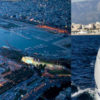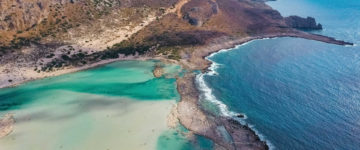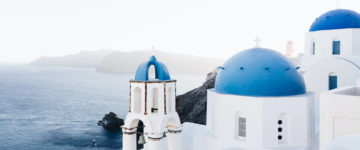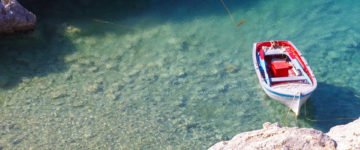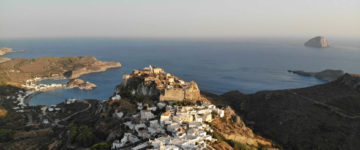
With a population of 4960 volcanic Milos arches around a central caldera and is ringed with dramatic coastal landscapes of colourful and surreal rock formations. The island’s most celebrated export, the iconic Venus de Milo, is far away in the Louvre but hot springs, the most beaches of any Cycladic island and a series of quaint villages populated by friendly people add to its current, compelling, attractions.
Capital Plaka and stunning Klima are just two of the little villages worth visiting and Filakopi, an ancient Minoan city in the island’s northeast, was one of the earliest settlements in the Cyclades.
The island has a fascinating history of mineral extraction dating from the Neolithic period when obsidian was exported to the Minoan world of Crete. Today Milos is the biggest bentonite and perlite centre in the EU.
Supercharming Plaka with a population of 877 inhabitants embodies the Cycladic ideal with its white houses and labyrinthine lanes perching along the edge of an escarpment. Plaka was built on the site of Ancient Milos, which was destroyed by the Athenians and rebuilt by the Romans. It meanders straight into the settlement to the south, Trypiti (with about 490 inhabitants), and they both rise above several villages converging to the southwest. Plaka’s main church courtyard has spectacular views and gets packed out for sunset in high season. The volcanic nature of the island of Milos has endowed it with a very dramatic beauty many-fiord like beaches with strange rock formations and with many colors. Unfortunately, because of its mineral wealth, the island is heavily mined and a lot of its scenery has been raped by the miners. With a population of 4960 volcanic Milos arches around a central caldera and is ringed with dramatic coastal landscapes of colourful and surreal rock formations. The island’s most celebrated export, the iconic Venus de Milo, is far away in the Louvre but hot springs, the most beaches of any Cycladic island and a series of quaint villages populated by friendly people add to its current, compelling, attractions.
Capital Plaka and stunning Klima are just two of the little villages worth visiting and Filakopi, an ancient Minoan city in the island’s northeast, was one of the earliest settlements in the Cyclades. The island has a fascinating history of mineral extraction dating from the Neolithic period when obsidian was exported to the Minoan world of Crete. Today Milos is the biggest bentonite and perlite centre in the EU.
Supercharming Plaka with a population of 877 inhabitants embodies the Cycladic ideal with its white houses and labyrinthine lanes perching along the edge of an escarpment. Plaka was built on the site of Ancient Milos, which was destroyed by the Athenians and rebuilt by the Romans. It meanders straight into the settlement to the south, Trypiti (with about 490 inhabitants), and they both rise above several villages converging to the southwest. Plaka’s main church courtyard has spectacular views and gets packed out for sunset in high season.
The volcanic nature of the island of Milos has endowed it with a very dramatic beauty many-fiord like beaches with strange rock formations and with many colors. Unfortunately, because of its mineral wealth, the island is heavily mined and a lot of its scenery has been raped by the miners.

